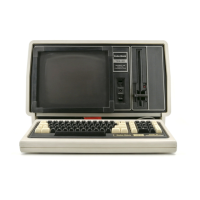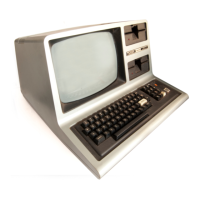Operation
Manual
Computer
Graphics
-----------TRS·BO
®
----------
1
CLEAR
l~~
5
SCREEN
~
l~
TILE$(~)=CHR$(&H22)+CHR$(&H~~)
2~
TILE$(l)=CHR$(&HFF)+CHR$(&H~~)
3~
TILE$(2)=CHR$(&H99)+CHR$(&H66)
4~
TILE$(3)=CHR$(&H99)
5~
TILE$(4)=CHR$(&HFF)
6~
TILE$(5)=CHR$(&HF~)+CHR$(&HF~)+CHR$(&H~F)+CHR$(&H~F)
7~
TILE$(6)=CHR$(&H3C)+CHR$(&H3C)+CHR$(&HFF)
8~
TILE$(7)=CHR$(&H~3)+CHR$(&H~C)+CHR$(&H3~)+CHR$(&HC~)
9~
A$=TILE$(~)+TILE$(1)+TILE$(2)+TILE$(3)+TILE$(4)
+TILE$(5)+TILE$(6)+TILE$(7)
l~~
PAINT(3~~,1~~),A$,1
This
example
paints
the
screen
with
a
tiling
pattern
made
up
of
eight
individually
defined
tile
strings
(~-7).
'POINT
(function)
Returns
Pixel
Value
The
&POINT
command
lets
you
read
the
OFF/ON
value
of
a
pixel
from
the
screen.
Values
for
&POINT
that
are
off
the
screen
(i.e.,
PRINT
&POINT
(8~~,5~~»
return
a
-1,
signifying
the
pixel
is
off
the
screen.
Example
l~
PSET(3~~,1~~),1
2~
PRINT
&POINT(3~~,1~~)
---------ltadl8lhaell---------
-4~-

